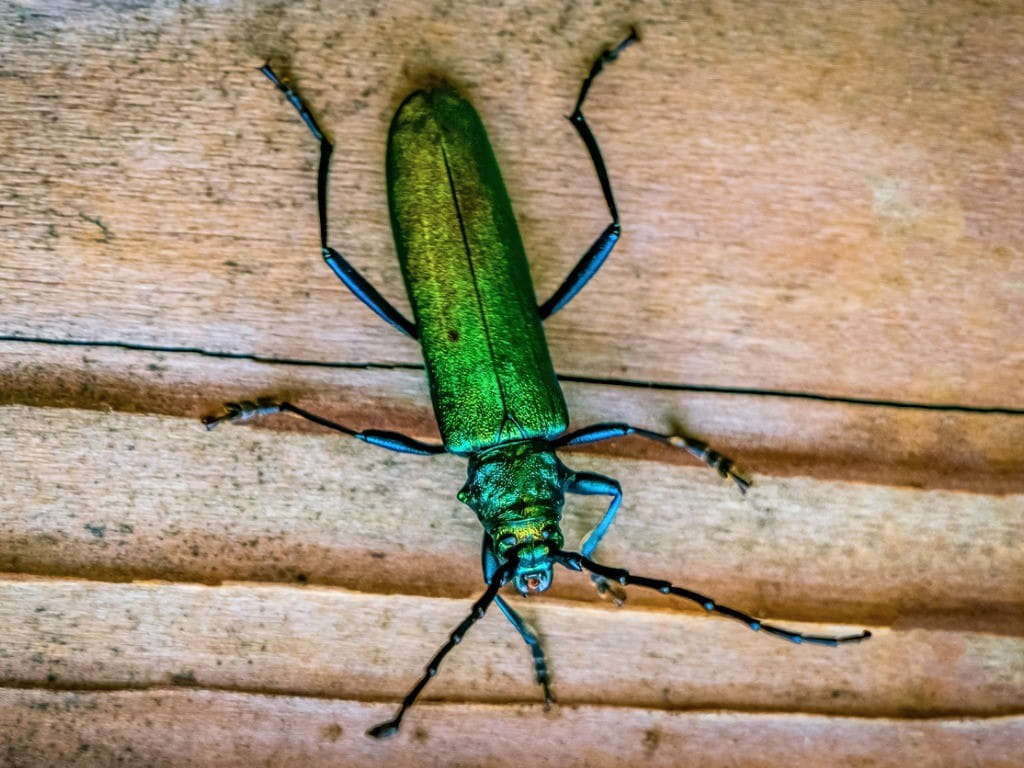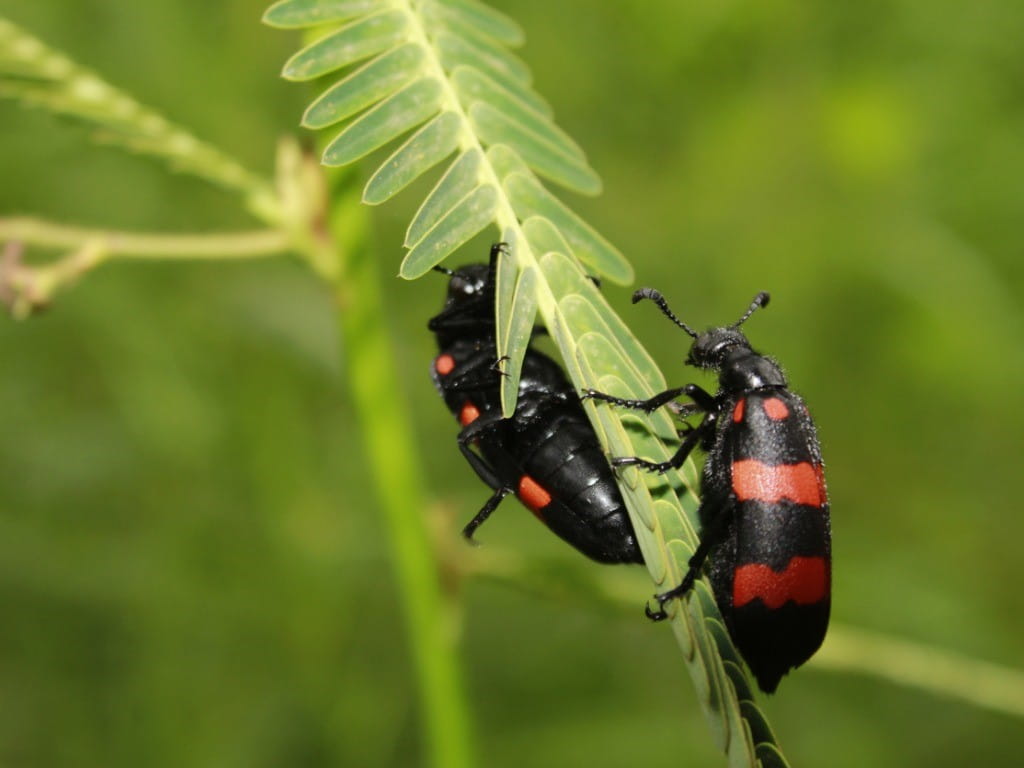Blister Beetles: Do Not Touch!

The Bottom Line
Blister beetles excrete a toxic blistering agent called cantharidin, which can cause irritation and blistering when it comes in contact with the eyes, skin, mouth, throat, or digestive tract. The irritation and blisters that form can be painful but usually are not life-threatening. Blister beetles are notorious for their ancient use as an aphrodisiac. Not only is such use groundless, it can also be fatal.

The Full Story
Blister beetles get their name from their defense mechanism. In response to danger, they excrete a toxic body fluid called cantharidin through their leg joints. Cantharidin is a colorless and odorless fatty fluid that is toxic and can cause blisters upon contact.
Blister beetles are plant-eating insects belonging to the beetle family Meloidae. They're native to the eastern US as well as parts of Europe, Africa, and Asia and range in size from 1 to 2.5 cm. They vary widely in color and markings. They have soft and leathery bodies and large heads relative to their small torsos and narrow necks. They may look ordinary (dull gray or black) or ominous (with bright colors, like bright yellow with black stripes). They are often found on flowering plants.
Cantharidin is more popularly known as Spanish fly, which is the common name for a specific kind of emerald green blister beetle native to southern Europe. This name can be confusing because the beetle is neither a fly nor only from Spain. What is important to know is that it's notorious for its historical use as an aphrodisiac and for treating various ailments dating back thousands of years. It has had a wide array of uses in traditional and folk medicine in China for over 2000 years. Hippocrates treated patients with swelling using ground blister beetles. The French writer and soldier, the Marquis de Sade, poisoned a few women in 1772 after giving them candy containing cantharidin as a sexual enhancement. There are more recent, sporadic reports of poisoning with cantharidin when people attempted to use it as an aphrodisiac or ingested it on a dare. The purported aphrodisiac properties were due to its extremely irritating effects, which lead to swelling in the pelvic area after ingestion (the same blistering effect seen on the skin also occurs in the digestive and urinary tracts). Thus, its use as a sexual enhancer can hardly be pleasant and might even be fatal. Because of its danger and lack of documented efficacy, the US Food and Drug Administration revoked its approval of cantharidin in 1962.
The effects of cantharidin are due to its highly irritating effects on whatever tissue is exposed. Contact with skin can lead to burns and blisters immediately or in a delayed fashion. Rarely, from large exposures, cantharidin can also be absorbed through the fat layer of the skin to cause body-wide effects such as sweating, rapid heart rate, and kidney damage. When swallowed, swelling of the lips, mouth, and throat as well as trouble swallowing, abdominal pain, vomiting, and blood in the urine can occur. Severe effects from ingestion include kidney damage and shock. When the eyes are exposed, either directly or from accidental hand-to-eye contamination, the result can be pain, tearing, decreased vision, and damage to the cornea.
There is no specific antidote for cantharidin. Care is targeted toward treating the symptoms, not the poison. Most encounters with blister beetles are benign and non-life-threatening. If blisters or welts form, they are uncomfortable but usually not serious. The best initial treatment is to remove the cantharidin from whatever surface it has come into contact with, like the skin or eyes, by rinsing gently with water. After that, specific therapies such as corticosteroids to reduce inflammation and antibiotics to treat skin infection from open wounds can be prescribed. Consultation with an eye doctor might be necessary for eye exposures. Finally, it is important to be sure that a tetanus vaccine update is obtained if not already up to date.
If you're concerned about exposure to a blister beetle, check the webPOISONCONTROL® online tool or call Poison Control at 1-800-222-1222 for guidance.
Serkalem Mekonnen, RN, BSN, MPHCertified Specialist in Poison Information
Poisoned?
Call 1-800-222-1222 or
Prevention Tips
- Do not touch, handle, provoke, or crush blister beetles.
- If you encounter a blister beetle or if it lands on you, do not attempt to slap or crush it. Gently blow it away or remove any clothing on which it has landed, and then wash the exposed areas with soap and water.
- Be careful not to touch/rub your eyes or any other parts of your body after touching or coming into other contact with a blister beetle.
- Wear rubber or plastic gloves, long sleeves, and long pants when gardening in areas where blister beetles have been seen.
This Really Happened
A 10-month-old girl began to gag and cough while out in her yard. She became irritable and then vomited an insect that was gray in color. She vomited again and a small amount of blood was seen. Blood was also seen in her urine when her diaper was changed a few hours later. She continued to cry and appear quite irritable. She was taken to a hospital; her symptoms resolved and she fully recovered.
As part of the investigation to figure out the cause of her symptoms, samples of whatever she had vomited were examined. The insect was identified as a blister beetle. Her father also recalled having repeated episodes of blisters on his skin after working in his garden (From Wertelecki et al, 1967).
For More Information
References
Repplinger DJ, Hahn I-H. Arthropods. In: Nelson LS, Howland MA, Lewin NA, Smith W, Goldfrank LR, Hoffman RS, editors. Goldfrank's toxicologic emergencies. 11th ed. New York: McGraw-Hill Education; 2019.
Poisoned?
Call 1-800-222-1222 or
Prevention Tips
- Do not touch, handle, provoke, or crush blister beetles.
- If you encounter a blister beetle or if it lands on you, do not attempt to slap or crush it. Gently blow it away or remove any clothing on which it has landed, and then wash the exposed areas with soap and water.
- Be careful not to touch/rub your eyes or any other parts of your body after touching or coming into other contact with a blister beetle.
- Wear rubber or plastic gloves, long sleeves, and long pants when gardening in areas where blister beetles have been seen.
This Really Happened
A 10-month-old girl began to gag and cough while out in her yard. She became irritable and then vomited an insect that was gray in color. She vomited again and a small amount of blood was seen. Blood was also seen in her urine when her diaper was changed a few hours later. She continued to cry and appear quite irritable. She was taken to a hospital; her symptoms resolved and she fully recovered.
As part of the investigation to figure out the cause of her symptoms, samples of whatever she had vomited were examined. The insect was identified as a blister beetle. Her father also recalled having repeated episodes of blisters on his skin after working in his garden (From Wertelecki et al, 1967).
